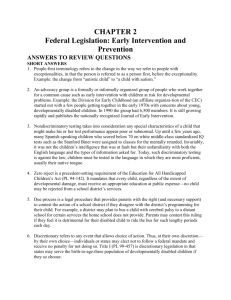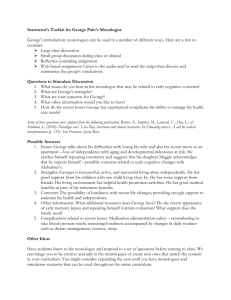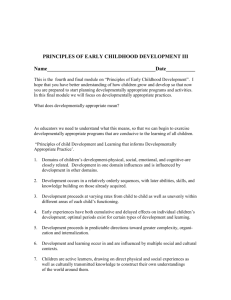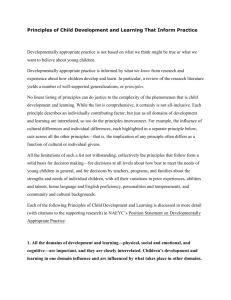aging in developmental disabilities
advertisement
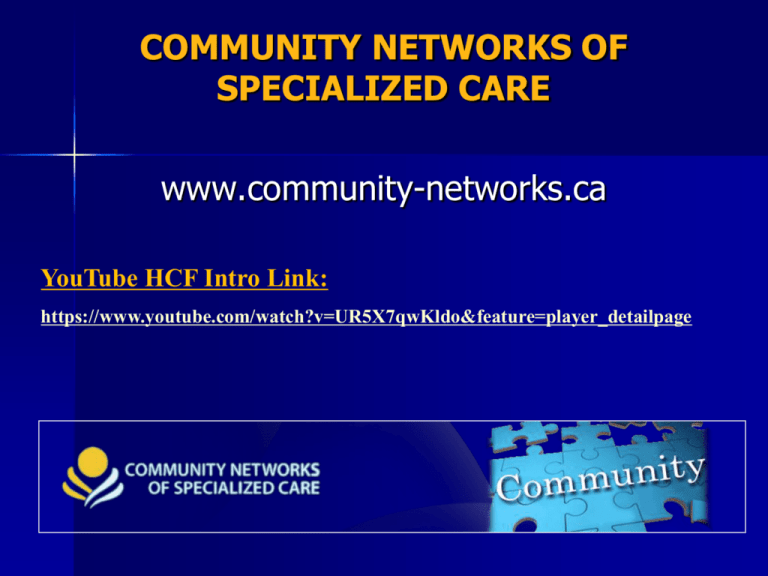
COMMUNITY NETWORKS OF SPECIALIZED CARE www.community-networks.ca YouTube HCF Intro Link: https://www.youtube.com/watch?v=UR5X7qwKldo&feature=player_detailpage AGING IN DEVELOPMENTAL DISABILITIES DR.JAY RAO M.B.B.,S. ,D.P.M. ,M.R.C.PSYCH(U.K.)., F.R.C.P.(C). ASSOCIATE PROFESSOR UNIVERSITY OF WESTERN ONTARIO LIFE EXPECTANCY AND AGING IN DEVELOPMENTAL DISABILITIES 1. 2. 3. 4. 5. LIFE EXPECTANCY WAS LOW IN THE 1920s. For Down’s, it was in the early 20s. A large number were in institutions. Cause of death was usually Bronchopneumonia. TODAY, LIFE EXPECTANCY IS AROUND 67 YEARS OF AGE. Context of aging General population Developmentally Disabled there are declines in speed of There may be pre-existing cognitive problems Pre-existing Health and nutrition problems Pre-existing psycho-social problems processing, working memory, inhibitory functions, long term memory, decreases in brain structure and white matter integrity (Parks, Reuter-Lorenz) Medical morbidity, health and nutritional risks increase Psycho-social problems gather force Three Factors to be considered in aging Neuro-medical vulnerabilities Neuro-developmental issues Ex: Scaffolding Neuro-Executive Issues Developmentally Disabled at higher risk for these DD at disadvantage due to developmental immaturity of brain architecture Pre-existing executive brain dysfunction Neuro-developmental issues--- Scaffolding In the younger brain: specialization of circuitry Ex: Remembering, working memory tasks, Novel tasks In response to challenges, initially, a wider set of neural circuits are recruited. These are Scaffolds As the task is over-learned, a specific, honed circuit is developed. This provides the ability for efficient cognitive operations In the older brain - Firstly>> Scaffolds are invoked even to perform familiar tasks and basic cognitive processes Ex: (working memory tasks): Young focal, left Para-hippocampal activation Old Wider Right and left pre-frontal brain activation In the older: secondly>>> Scaffolds (wider net works) are recruited even for low levels of task demand (remembering where one put the car keys) In the older: thirdly >>> Generating scaffolds and recruiting them is even more inefficient because of aging pathology In the older Developmentally disabled we propose Scaffolding, even in younger ages is inefficient There is impaired ability to recruit Pre-frontal networks, especially bilaterally In older ages neurobiological decline is rapid or more profound in its impact resulting in poor scaffolding capacity Whatever scaffolding there is , is penetrated by neural pathology leading to collapse of the scaffolds (Parks, Reuter-Lorenz; Burke and Barnes;) Neural Connections in Autism Frontal and Temporal development is stunted at an early stage leading to lack of differentiation This lack of differentiation leads to hyper-connectivity Blocks coherence development with other critical brain regions Connectivity problems HYPO-connectivity Orbito-frontal Mixed sensory-motor Occipital/Parietal- Temporal Frontal-posterior Left Intra-hemisphere HYPER-connectivity Frontal-temporal Left Hemisphere intra- hemispheric EXECUTIVE FUNCTIONS Executive Functions Inhibit Shift Emotional Control Monitor Working Memory Plan/ organize Organization of Materials Task Completion Orbitofrontal: Disinhibition Lability Irritability Impulsivity Sexual preoccupation Distractability – May go unrecognized Lobes of the Brain Ventromedial PC: Decreased verbal output Diminished motor initiation Withdrawal apathy Lobes of the Brain Dorsomedial PC: Apathy Akineticmutism incontinence Lobes of the Brain Dorsolateral PC: Working memory Spatial Object-faces Verbal Executive functions Language sequencing Caudate-putomen-orbitofrontal: OCD Response bias toward stimuli related to socioterritorial concerns about danger, violence, hygiene, order, sex mediated by orbitofrontal-subcortical circuits Inadequate repression (filtering) in caudate of input from the orbital cortex (worry) Cortex – (caudate) – globus pallidus Thalamus takes over Frontal lobe: Dysfunction results in: Disinhibition Emotional lability Irritability Lack of drive, motivation Deficits in memory Attentional deficits Apathy – akinesia – Abulia Aphasia Temporal lobe: Dominant: Euphoria Auditory hallucinations, illusions Thought disorder Anterograde amnesia Receptive language deficits Memory impairment Non-dominant: Dysphoria Disinhibition of sexual and aggressive behaviours Cognitive difficulties Parietal: Dominant: Alexia, agraphia, acalculia Agnosis, left-right disorientation Non-dominant: Impaired spatial ability Anosognosia Autopagnosia Apraxia, etc. Occipital: Disturbed spatial orientation (metamorphopsia) Visual illusions Visual hallucinations, etc. DOWN SYNDROME AND AGING 1. Predilection to early Alzheimer’s 2. However, many questions still not satisfactorily answered. A) there has been no methodologically satisfactory population based study of Down’s B) No Neuro-pathological confirmation on a large enough sample. Therefore calculation of the size of the problem skewed. DOWN SYNDROME AND ALZHEIMER’S Brains of Down’s adults shows Alzheimer’s like organization. In most of these, there is no clinical evidence of cognitive decline. Other conditions mimic Dementia (Depression) No comparison of similar IQ bearing syndromal groups with Down’s. Continued: However, the Incidence and Prevalence of Dementia may be higher in Down’s. But we have no population based data on Incidence and prevalence in other Developmentally disabled for specific comparison. Alzheimer’s-like brain pathology alone does not indicate Alzheimer’s in Down’s. Down’s, even in their 20s may have such brain configuration without actually manifesting any clinical decline. CASE HISTORY - I Depression as Dementia 38 yr. old female, admitted with two months history of poor memory, disinhibition, emotional dyscontrol, incontinence of urine and bowels. Worked as a cashier in a store for 12 years previously ( job shadowing) All investigations normal. Mental status exam unproductive CASE HISTORY - II DEMENTIA AS DEPRESSION: 67 year old man in a group home, previously well functioning, gradually became more withdrawn, irritable, forgetful, paranoid, impulsive. Did not enjoy activities, became very quiet. Treated with anti-psychotics, anti-depressants. Became more irritable, rages, Parkinsonian Neuro psychological assessment revealed serious deficits. MRI indicated degenerative changes AGING AND Developmental Disability As in the general population, aging brings the following problems: 1. 2. 3. 4. PHYSICAL PROBLEMS Cardiovascular disease Musculo-skeletal disease Gastro-intestinal problems Sensory problems Psychiatric problems ( HIGHER INCIDENCE AS ONE GETS OLDER) 1. Depression 2. Anxiety disorders 3. Mood disorders 4. Psychosis COGNITIVE PROBLEMS Slower ability to process information Memory problems Attention Difficulties Executive function deficits (impulsivity, poor problem solving ability, difficulty in shifting, mood dysregulation) Communicational difficulties What is the BASE LINE? 1. 2. 3. 4. 5. Developmentally disabled may already have: Epilepsy Brain tumors (Tuberous sclerosis) Immature, miswired cortex. Eye (cataracts) and hearing problems Poor articulation, expressive and Receptive language problems What is the base line? Thyroid problems (ex: Down’s) 8. Cardiac defects (ex: Down’s, VCF, Tuberous Sclerosis) 9. GI malformations/ Swallowing difficulties 10. Kidney problems (tuberous sclerosis) 11. Skeletal Deformities 12. Lung/Immune deficiencies 7. WHAT IS THE BASE LINE? 13 14 15 16 Anxiety disorders. Mood instability Executive function deficits Memory and Attention difficulties Given such pre-existing conditions, the developmentally disabled are more likely to decline faster, with aging. Often, these are not known because of inadequate health evaluation. Older developmentally disabled experience: MORE LOSSES AND INCONSISTENCIES WHILE IN CARE POORER ACCESS TO MEDICAL FACILITIES FINANCIAL HARDSHIPS POORER NUTRITION LESS ACCESS TO RECREATION AND APPROPRIATE JOB/ OCCUPATIONAL INVOLVEMENT EVALUATION MULTIFACTOR EVALUATION is essential Careful researching of past medical history and family history. Multidisciplinary involvement Use of structured inventories/rating scales BUT REMEMBER: THESE SCALES ARE NOT DIAGNOSTIC INSTRUMENTS but tools to enable management INVESTIGTIONS CT, EEG,MRI,ULTRA SOUND,X-RAY BLOOD WORK – THE USUAL Neuro-cognitive assessments Skills assessments (OT) Treatment Assessment is the cornerstone Treat physical as well as psychiatric issues Dementia forms a small proportion of the problems in this population Physical decline, cognitive difficulties, isolation, loneliness, losses, poor nutrition, neglected health issues, mood instability are more pressing problems in this population Aging is a more challenging problem than dementia This is true in the developmentally disabled because of the neuro-biopsycho-social decline. As more of the developmentally disabled get older, we may need to develop strategies for support ,and anticipate the resource implications
